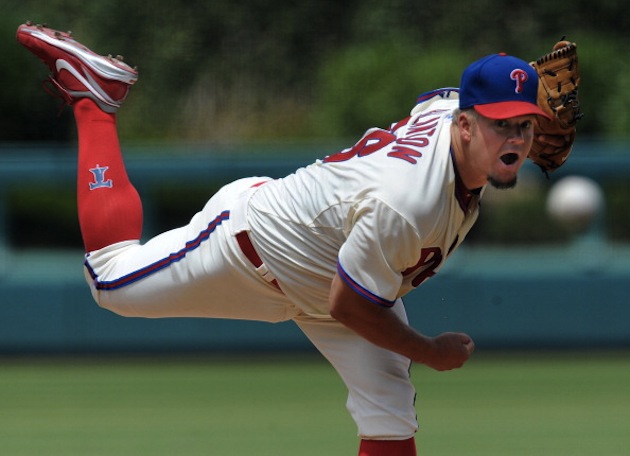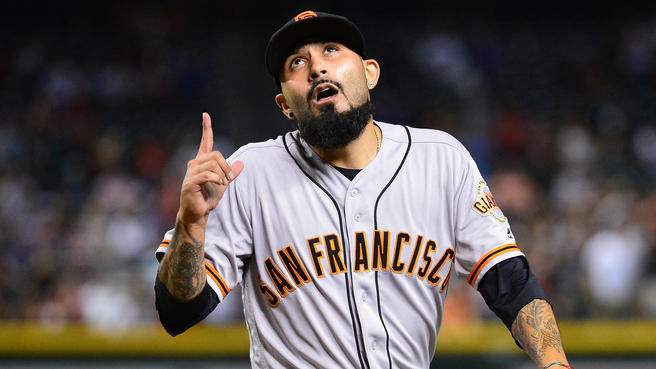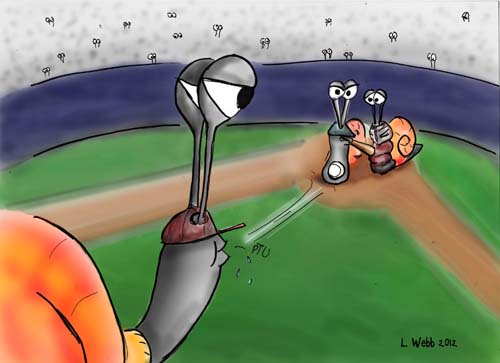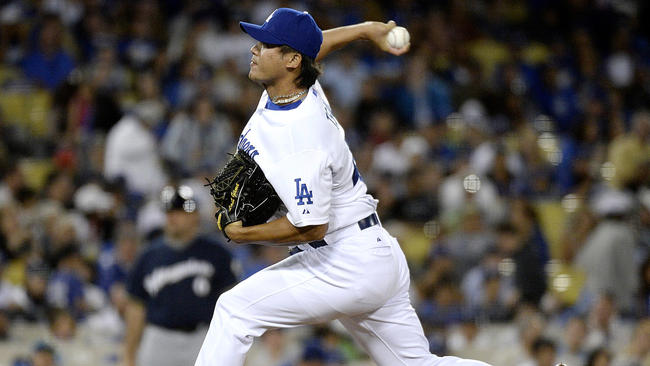Never have so many words been written about Joe Blanton within the last week. The Dodgers recently announced the signing of the 35-year old veteran hurler to a one-year four million dollar contract laden heavily with performance incentives. The deal initially seemed horrifying to many of us who had to suffer through his awful pitching for those two months back in 2012 when he was a Dodger.
We had thought that we would never see him again and breathed a heavy sigh of relief, until this last week of course. I once wrote at Lasorda’s Lair that I thought he was the worst pitcher in baseball and indeed he was at the time. After his awful stint with the Angels he had to reinvent himself in some way or shuffle off to buffalo. I hoped he would shuffle, alas he did not.
Chad Moriyama recently chronicled about his improved slider thanks to an improved grip. That’s how he reinvented himself and settled in as a middle reliever. Indeed it seemed to work as he had solid bodies of work with the Royals and Pirates. However if you look deeper at his numbers you can see that Blanton fared considerably better in Pittsburgh than he did in Kansas City. Perhaps there is a reason for that.
Delving deeper into this we can see that in his 41.3 innings with Kansas City he allowed 43 hits with a 3.89/3.59 ERA/FIP. That accumulated to a 9.3 hits per nine rate. Way too many base runners allowed. In his typical fashion he put up a very nice strikeout to walk line of 40/7 and he allowed six long balls in KC. Once he was acquired by the Pirates his numbers improved drastically.
Once a Pirate he posted a 5-0 record and in 34.1 innings pitched allowed just 26 hits and a 1.57/2.11 ERA/FIP with a 6.8 hits per nine rate. Once again his strikeout to walk line was a very good 39/9 and he allowed just one home run. Overall that came out to a 7-2 record, 2.84/2.92 ERA/FIP with 69 hits allowed in 76 frames. Giving him a very respectable 8.2 hits per nine innings pitched.
So is it possible that pitching in a more pitcher friendly park like PNC could have helped? Or perhaps Pittsburgh backstop Francisco Cervelli’s superior pitch framing played a large part? As you can see Blanton allowed a .783 OPS against at Kaufman Stadium and a .634 OPS against at PNC Park. However if you take a look at these numbers by catcher, you can see that he greatly benefited from Cervelli’s pitch framing abilities.
Pitch framing is all the rage these days with the stat kids. It’s the measurement of how often a catcher fools an umpire into calling a borderline pitch a strike. Pitchers and coaches love it because it obviously means more strikes. More strikes means more outs, and more outs means more wins. Since they have a stat for everything nowadays, they are able to measure pitch framing for each catcher. Each catcher is rated with a number called RAA which stands for runs above average. The better the pitch framer, and higher number of percentage of strikes called the higher the rating they get.
So if we take a look we can see that Cervelli was the number one rated pitch framer in all of baseball with a 26.7 RAA rating. Dodger’s catcher Yasmani Grandal was very good as well, ranking third with a 20.8 rating. Meanwhile Salvador Perez was one of the worst with a -9.1 rating. Cervelli had 201 borderline strike calls and 1.79 estimated calls per game while getting 10.7% of the pitches thrown outside of the strike zone called his way. Perez posted just 6.5% in 2015.
Lo and behold if we look at Blanton’s numbers by catcher we see the difference.
When Perez Caught Blanton – 3.98 ERA 40.2 IP .266 BAA (42 for 158) .753 OPS 38K/6BB
When Cervelli caught Blanton- 1.53 ERA 29.1 IP .206 BAA (22 for 107) .558 OPS 34K/7BB
The difference is large even though it’s all a small sample size as the stat guys would probably claim. Regardless it’s still worth taking a look at. It’s a lot easier to get outs when you have a great catcher behind the plate framing all of your pitches and fooling umpires.
Perhaps the Dodgers are hoping that Yasmani Grandal and his excellent pitch framing abilities will be able to get the same results with Blanton in 2016. Only time will tell if this is the case.





Let me be the first to say that pitch framing, in my opinion, is one of those myth stats. I purposely watched very carefully last year and catchers don’t frame a pitch. Doing so would mean no movement of the glove and catching the ball in the glove as close to the strike zone as possible. Catchers yank the glove in from the outside and up if low. That is not framing. Framing would be stationery, not mobile.
The umpire has to look down past the catcher to where his glove is. He also has to call the pitch quickly without taking time to do that. Again, watching carefully, I don’t recall seeing umpires turn their heads downward when the pitch is in the catcher’s glove. I think we definitely do umpires a disservice to claim that the catcher and where he yanks his glove is the deciding factor on how the umpire makes a call. The ball-strike is where the pitch crosses the plate, not where the catcher catches it or yanks it.
How in heaven’s name can anyone assign a number to so called pitch framing? The observer would have to be inside the ump’s head to determine if he used the location of the catcher’s glove and ball in it to make a call? Can’t get much less scientific than that.
Agree Bluenose. As I said in the other thread, umpires will take note of this.
Let’s not forget an umpire got into it with AJ last year because he wasn’t displaying the pitch well enough.
If you don’t think certain catchers get more pitches called for their pitcher just watch Grandal and AJ in back to back games. AJ literally takes pitches out of the strike zone and that is just as much part of the pitch framing tracking.
I for one am all for computerizing the strike zone. It would give consistency to the game, it would speed up the pace of play, and it would take the strike zone away from CB Buckner.
Yes to electronic calling of balls and strikes.
I read in fangraphs that the differences of good framers and bad framers, is not really a big difference. And that umpires might have start having, a build in bias, aganist good framing catchers. Because an umpire doesn’t want to be tricked into calling balls that are out of the strike zone, strikes. So an umpire just might try to over correct calls, when so called good framers, are catching behind the plate, when an umpire, is umpiring. And to back this, Fangraphs showed a growing trend, that so called good framing catchers, are not having many consistent years, being good framers. And Badger has been saying this same thing, for quite a while, so it seems that there has been way to much credit given to the art of framing, especially compared to all the other great skills, that makes a good catcher. I remember when that umpire disrespected AJ, and I thought AJ, or the Dodgers, should have been able to report this umpire. I believe the difference in Blanton’s stats, from the Royals to the Pirates, was that Blanton had started some games for the Royals, and was only used in the pen, while he was a Pirate.
Totally agree. They can only be great pitch framers as long as they are “secret” pitch framers. Umpires can and do compensate quickly for any trends that threaten their domain. And why not?
To the extent that a catcher can catch a ball towards the fingertips instead of the glove pocket, a catcher can make a pitch appear to be as much as two inches right or left.
I think an umpire looks at the ball first and tries to call the pitch a ball or strike but on close pitches he might try to reassure himself and look at the catcher’s glove. By the time he looks, that glove has stopped moving. He would only see the glove move if he were calling balls and strikes based only on where the catcher caught the ball.
Also, if the pitcher hits the catcher’s glove where it is held he is going to get more strikes called then if the ball were in the strike zone but on the opposite side of the plate from where the catcher’s glove was held.
I said all that without ever sitting behind the plate with a pitcher throwing 90 + mph. It is my conjecture. I easily could be full of it.
It’s in the rule book. “The strike zone is that area directly over home plate.” Rule 2.0. The umpire is looking there and only there as the ball passes over it. By the time the catcher receives the ball it is 2′ past the strike zone. How a catcher catches the ball has nothing to do with where the ball pased through the strike zone. I find this “framing” concept laughable.
I’ll see if this works
http://www.theoleballgame.com/images/catchers-box-21724061.jpg
See where the hitter is? See where catcher is? See where the plate is? The strike runs directly over the plate between the top of the knee and a point midway between the belt and arm pits when the better is in his natural stance. The second part of that definition could be considered subjective, but the first part isn’t. The strike zone is over the plate. My only comment on what see here is I would set up maybe 6″ higher than this guy is. Some would argue by doing that you compromise angle on the bottom of the strike zone. I would say I understand that argument but I want a good angle on the corners and I don’t want to be screened by a catcher who might come up. I think it’s just preference. I will continue to argue there is no such thing as framing.
Badger were you Badger 3, on that other site?
Yes.
Bluenose,
The way they measure the framing is by using strike zone charts/maps like the ones you see on tv. The pitches that are thrown outside of the strike zone (according to the map) yet called a strike are the pitches that have been framed. It’s not exact yet, but they’ve gotten pretty close with it over the last few years. WHat it’s really for are those borderline pitches that look like balls but end up being called for strikes. You can see the way the catchers move their mitts in order to pull the ball back into the strike zone. It’s done very quickly and at times so quick you can’t see it with the naked eye.
You know the saying the hand is quicker than the eye? That’s what framing is all about really. Of course every umpires strike zone is different and the zones are different between leagues. The word framing is probably more of a misnomer titling, but that is what it’s called.
At best it is a misnomer and at worse, if it does exist, is stealing from blind umpires.
Welcome back, Scott. Good to see you around. Will def be a place to vent, lol.
Thank you! Yes indeed, vent as much as you want over here. Everyone is welcome to complain
Scott, this is a very clean website. Congratulations. I hope you look at adding the Disqus plugin for comments.
Thank you Bumsrap! Welcome aboard!
Yes I will be adding Disqus very soon, once I finish getting all of the tweaks and settings finished.
I agree with Bumsrap, so far so good. Hope you can keep it civil here.
I have another theory about pitch framing. I think Grandal gets banged up because he tries to catch the ball on the edges of the glove instead of the pocket and that causes more balls to tip off his glove and into his face mask and chest.
If Blanton has reinvented himself, and can be a solid contributor, I am all for it, but I reserve the right to reserve judgement until a later date
Ahhh, we’re all back here now? I feel like the Raiders; homeless and don’t know where to go!!
Good luck with the site Scott. I will say I’m not a big fan of the blurry photo of Tommy taking a fall as the first thing we see. I’ve always enjoyed your opinions at Lasorda’s Lair and LADT.
Thank you Hawkeye!
You might see that image above change from time to time. For the first few weeks it will be of Tommy
Framing is a “Thing” like it or not, and the best framers are up there every year. Maybe the umps will get wise to it and favor the catchers who aren’t good framers, but it hasn’t happened yet. The truth is, I don’t think they have enough time to consider it.
Framing isn’t just sliding a glove or tricking an umpire. It’s the posture, movement, positioning and a number of other subtle things. It helps… maybe not a lot, but over 162 games it all adds up. Valuing pitch framing is here to stay until they start calling strikes and balls electronically! The technology is here. Why use a rotary phone when we have Smart Phones?
Baseball needs to get outta’ the Dark Ages. Electronic balls and strikes will make it a better and faster game with increased integrity. Great Job, Scott. Keep getting better…
I umpired for 10 years. Not once in ten years did where a catcher caught the ball change where the ball was when it went over the plate. If you were to ask any professional umpire they would tell you the same thing. If you look at it logically, you will see I am right about this. Look at the picture I posted. The catchers glove has NOTHING to do with the strike zone. I think framing is a “thing” made up by nerds who didn’t play the game much and sure as hell didn’t umpire for a living.
And yet over the course of a season, guys like Yasmani Grandal and Francisco Cervelli get literally hundreds more strikes called than guys like A.J. Pierzinski and Carlos Ruiz. Why do you think that is?
I know this is probably a waste of time because you clearly have already decided that framing is ‘a stat made up by nerds’ but if that were true, why would catching coaches like Steve Yeager be trying to teach guys like A.J. Ellis how to do it?
When you’re watching the games, do you ever disagree with an umpire’s call? Did anyone ever disagree with your calls when you were an umpire? You seem to think that ‘the plate is the plate’ and nothing the catcher does could possibly affect what the umpire sees but then why do umpire’s sometimes call a pitch that should have been a ball a strike? And why do they consistently miss these calls more often for certain catchers?
You can disagree with anyone’s evaluation of the value of pitch framing all you want, but to actually say that it doesn’t happen just isn’t backed up by reality.
Why you see water ads on this site:
https://support.google.com/adwords/answer/2454000?hl=en
I got some info on that after Scott said he didn’t pick the ads.
“How does one find advertisers right off the bat?
You don’t actually do it yourself. You join an ad network or exchange and
then put their tags (code) on your site. Advertisers buy from them, and
they decide which ads get sent to you. You get paid on how well they do,
according to them.”
What software does one use for this? DFP by Google is the common choice.
Several good reads on framing and blocking. Umpires will change the stats:
http://www.fangraphs.com/blogs/the-beginning-of-the-end-for-pitch-framing/
Thanks Badger that is the article I was talking about.
Companies like mine bid on ad space. I write Google a check every month for almost 6 figures!
It helps Scott defray expenses and it’s not a bad thing.
Congrats on your site Scott. As far as pitch framing goes, I guess its also influenced by the umpire. If he feels the catcher is deliberately trying to win the strike he will be less likely to call it a strike.
All you need to know about pitch framing was in game 3 of the 2013 playoffs against the Cards. Ryu couldn’t buy a strike on the corners and Lackey was getting at least 6 inches off plate inside and outside. Molina got the calls Ellis didn’t.
Ron FF I remember that game, and I remember that Umps name, because he was so bad. I think that was all about a bias for Yadi, and the Cardinals. It felt like the Dodgers were the U. S., playing the Soviet Union, in the Olympics. Remember when all of the countries associated with the iron curtain, use to always vote against the U.S. and all vote for each other.
Again, it’s not just slight of hand. It’s the whole body of work by the catcher. You can look at video all day and I don’t think you can tell the difference, and before you say it’s the pitchers, consider that good framing catchers who change teams are also good framers for their new team. It’s not a huge deal, but it’s a deal. Who knows – part of it may be the catcher’s relationship with the umpire? It’s possible the way they communicate with the ump and the respect they show (“How’s the wife and kids, Don?”) that gets them more calls. That’s why I say it’s not moving the glove that gets it done. That is silly!
It looks like we are up and running. Thanks Scott. A decision on Blanton will be made at the end of May. If he does not do well, he will be gone. Basically, the Dodgers are giving him 4 million for a 2 month try out.
Every umpire is graded by performance and that includes his strike zone. It’s a strike or it isn’t, and if an umpire isn’t getting it right he will hear about it. If he’s easily fooled then he should be expeditiously fired.
Getting paid for a blog is not a bad thing. It’s a lot of work.
6 figures to Google? Maybe you can help Flint Mark.
We have been slammed with calls from Flint.
https://www.uswatersystems.com/blog/2016/01/flint-michigan-be-very-afraid/
https://www.uswatersystems.com/blog/2016/01/flint-michigan-be-very-afraid/
Which wordpress template are you using on your website? Is it from these guys by any chance: http://www.nuttythemes.com
No, why?
We just wanna say thnx to you 4 creating this cool site and keep up the good work!